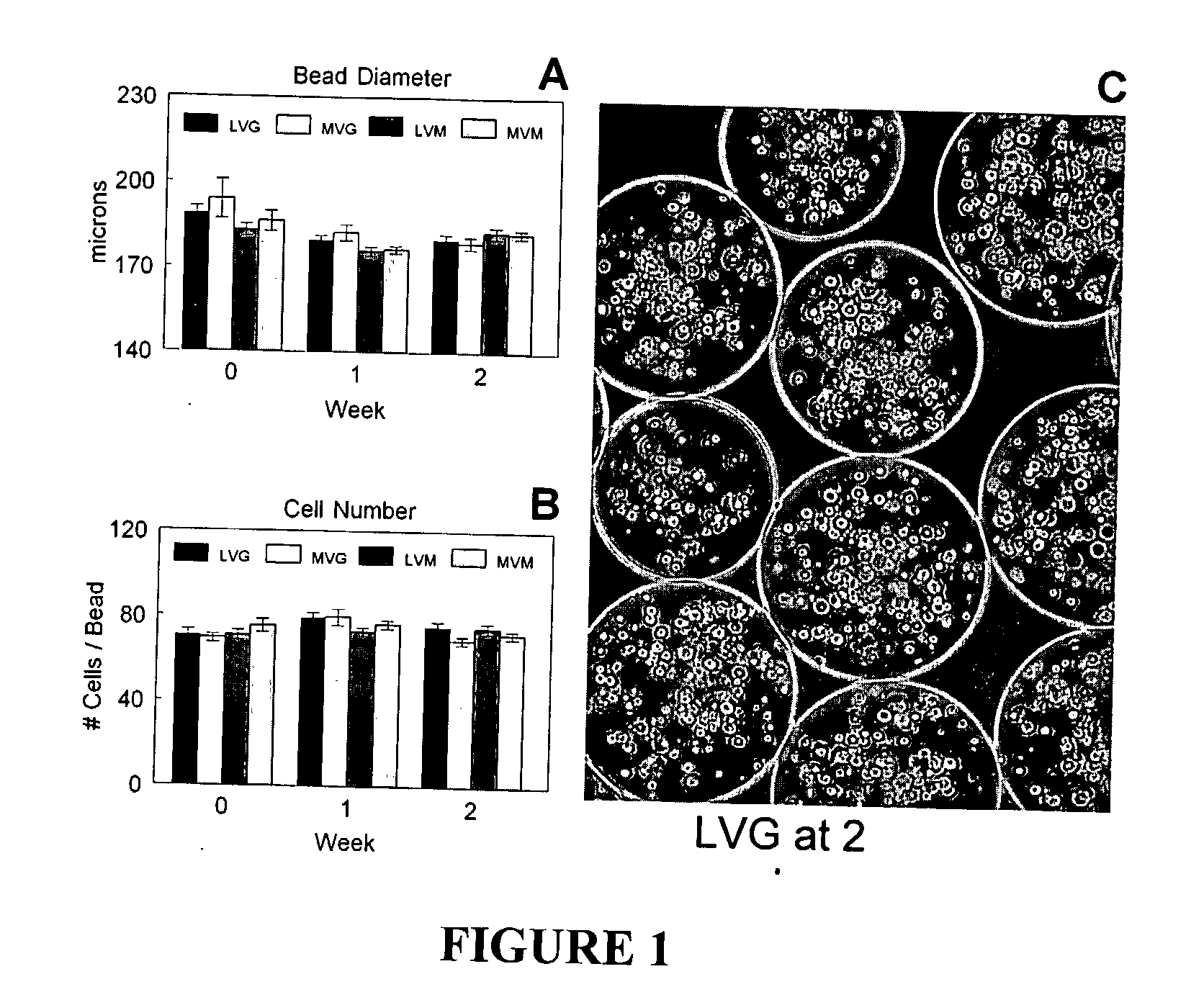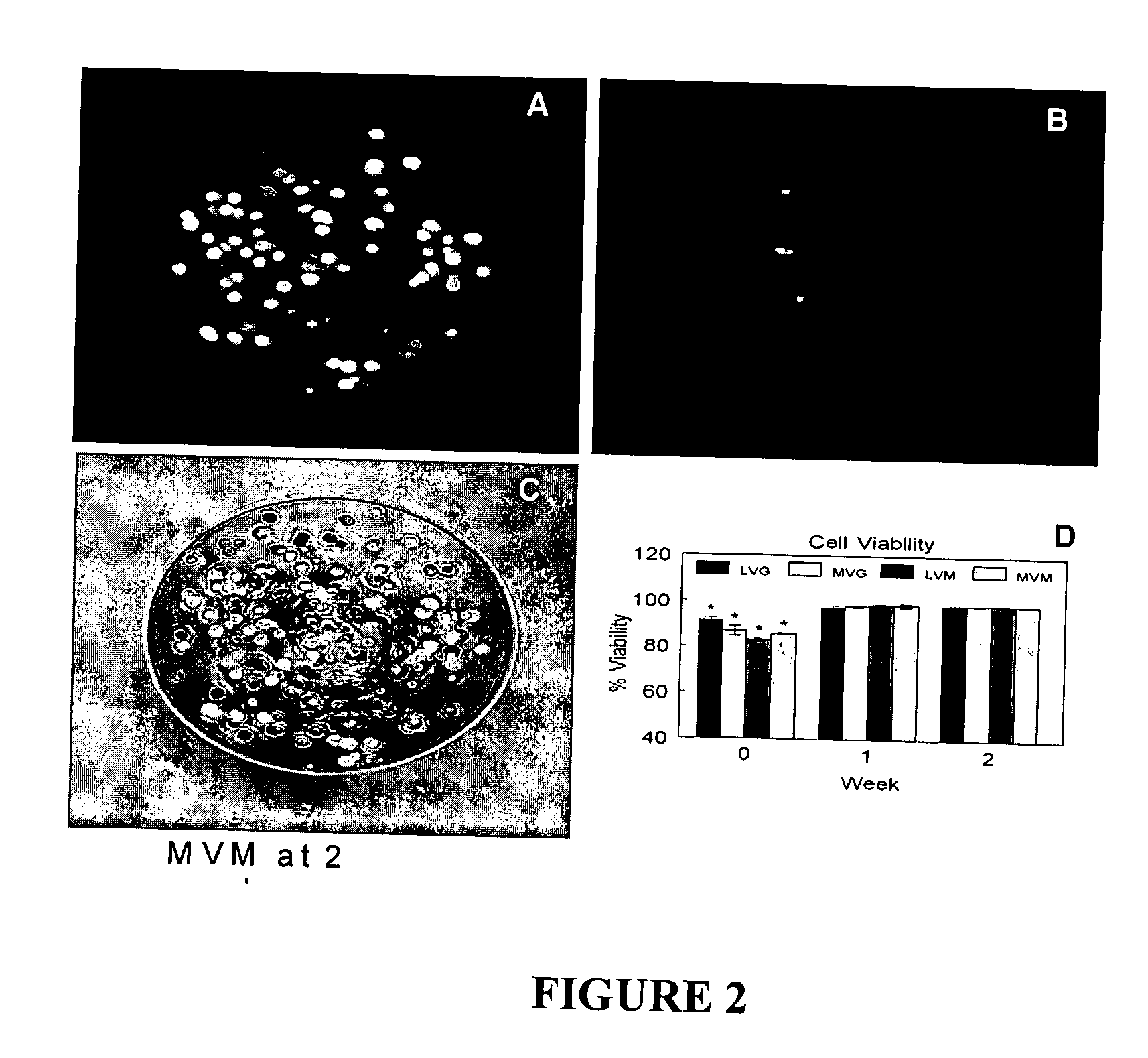Microencapsulation of Cells in Hydrogels Using Electrostatic Potentials
a technology of electrostatic potential and microencapsulation, which is applied in the direction of skeletal/connective tissue cells, drug compositions, biocide, etc., can solve the problems of difficult to standardize the number of cells contacted with various test compounds, difficult to assess meaningful comparisons between compounds, and difficult to incorporate cell based assays into hts assays
- Summary
- Abstract
- Description
- Claims
- Application Information
AI Technical Summary
Benefits of technology
Problems solved by technology
Method used
Image
Examples
example 1
Encapsulation of Cells
[0090] Ultrapure alginate compositions containing polysaccharides with ≧60% guluronate or mannuronate resides with average molecular weights > or 6 cells / ml. The solution was then extruded through a 0.18 mm (inner diameter) needle at 10 ml / hr. A 6,000 kV electrostatic potential between the CaCl2 polymerization solution and the needle was used to disrupt the surface tension. Bead size and total cell number per bead were determined by morphometric analysis.
[0091] Cell number and bead size were controlled by varying the distance the cell suspension dropped before hitting the polymerization solution. Additional parameters were modulated according to the following generalized equations to obtain encapsulated cells having a diameter of less than 200 μm and containing a predetermined number of cells. Pi-Po=2 γRPo=FsAA=4 π R2Fs4 π R2-Po=2 γRFs=4 π R2(2 γR+Po)
[0092] Pi=pressure inside droplet
[0093] P0=pressure outside droplet (atmospheric pressure...
example 2
Effect of Alginate Composition on Microencapsulation
[0103] Alginate is co-polysaccharide composed of guluronate and mannuronate residues. The residue ratio and length of the polymer chains affect the mechanical properties of the alginate hydrogel. Four different alginate formulations (Table 2) were compared based on bead morphometrics and cell viability during two weeks of in vitro culture.
TABLE 1Optimization of Microencapsulation ProcessAlginateBeadCellGelation SolutionConcentrationMorphologyViability100 mM CaCl22.0%Spherical50 mM CaCl2 + 75 mM2.0%Irregular˜50%NaCl20 mM CaCl2 + 120 mM2.0%Irregular˜70%NaCl50 mM CaCl2 + 150 mM2.0%Spherical˜90%Glucose
[0104]
TABLE 2Alginate CompositionsGuluronate ContentMolecular Weight>60%LVGLVM>200,000 g / moleMVGMVM
[0105] The average bead diameter was 176±2 μm to 194±7 μm depending on the alginate composition used (FIG. 1A), but there was not statistically significant difference. In addition, no significant change in bead diameter was measured durin...
example 3
Viability of Encapsulated Cells
[0106] The viability of the encapsulated chondrocytes was measured by fluorescent confocal microscopy and a live / dead stain consisting of calcein and ethidium homodimer-1. The calcein stains the cytoplasm of the live cells green (FIG. 2A) and the ethidium stains the nucleus of dead cells red (FIG. 2B). The live cells were evenly distributed throughout the beads (FIG. 2C) with an initial viability if 83% to 91% (FIG. 2D). The viability increased after one week in culture to greater than 98% for all alginate compositions and remained constant up to two weeks. No statistically significant differences were observed between the different alginate compositions on cell viability during the in vitro culture.
PUM
| Property | Measurement | Unit |
|---|---|---|
| diameter | aaaaa | aaaaa |
| diameter | aaaaa | aaaaa |
| bead diameter | aaaaa | aaaaa |
Abstract
Description
Claims
Application Information
 Login to View More
Login to View More - R&D
- Intellectual Property
- Life Sciences
- Materials
- Tech Scout
- Unparalleled Data Quality
- Higher Quality Content
- 60% Fewer Hallucinations
Browse by: Latest US Patents, China's latest patents, Technical Efficacy Thesaurus, Application Domain, Technology Topic, Popular Technical Reports.
© 2025 PatSnap. All rights reserved.Legal|Privacy policy|Modern Slavery Act Transparency Statement|Sitemap|About US| Contact US: help@patsnap.com



